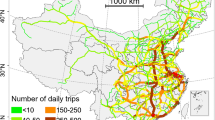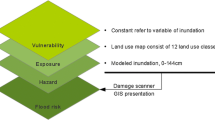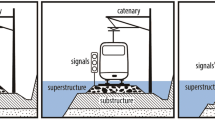Abstract
Rainfall-induced hazards, such as landslides, debris flows, and floods, cause significant damage to railway infrastructure. However, an accurate assessment of rainfall-induced hazard risk to railway infrastructure is limited by the lack of regional and asset-tailored vulnerability curves. This study aims to use multisource empirical damage data to generate vulnerability curves and assess the risk of rainfall-induced hazards to railway infrastructure. The methodology is exemplified through a case study of the Chinese national railway infrastructure. Regional- and national-level vulnerability curves are derived based on historical railway damage records. These curves are combined with the daily precipitation data and the railway infrastructure market value to estimate regional- and national-level risk. The results show large variations in the shape of the vulnerability curves across the different regions. The railway infrastructure in Northeast and Northwest China is more vulnerable to rainfall-induced hazards due to low protection standards. The expected annual damage (EAD) ranges from 1.88 to 5.98 billion RMB for the Chinese railway infrastructure, with a mean value of 3.91 billion RMB. However, the risk to railway infrastructure in China shows high spatial differences due to the spatially variations of precipitation characteristics, exposure distribution, and vulnerability curves. The South, East, and Central provinces have a high risk of rainfall-induced hazards, resulting in the average EADs of 184 million RMB, 176 million RMB, and 156 million RMB, respectively, whereas the risks in the Northeast and Northwest provinces are estimated to be relatively lower. The usage of multisource empirical data enables risk assessments that include spatial details for each region. These risk assessments are highly necessary for effective decision making to achieve infrastructure resilience.








Similar content being viewed by others
References
Cardoso Pereira S, Marta-Almeida M, Carvalho AC, Rocha A (2020) Extreme precipitation events under climate change in the Iberian Peninsula. Int J Climatol 40:1255–1278. https://doi.org/10.1002/joc.6269
Diakakis M, Boufidis N, Salanova Grau JM et al (2020) A systematic assessment of the effects of extreme flash floods on transportation infrastructure and circulation: the example of the 2017 Mandra flood. Int J Disaster Risk Reduct 47:101542. https://doi.org/10.1016/j.ijdrr.2020.101542
Editorial Board of China Railway Yearbook (ed) (2001–2018) China railway yearbook. China Railway Publishing House, Beijing
Editorial Board of Zhengzhou Administrator’s Railway Yearbook (ed) (2001–2018) Zhengzhou administrator’s railway yearbook. Zhengzhou Administrator’s Railway Publishing House, Zhengzhou
Englhardt J, De Moel H, Huyck CK et al (2019) Enhancement of large-scale flood risk assessments using building-material-based vulnerability curves for an object-based approach in urban and rural areas. Nat Hazards Earth Syst Sci 19:1703–1722. https://doi.org/10.5194/nhess-19-1703-2019
Espinet X, Rozenberg J, Ogita KSRS, et al (2018) Piloting the use of network analysis and decision-making under uncertainty in transport operations: preparation and appraisal of a rural roads project in Mozambique under changing flood risk and other deep uncertainties
Gerl T, Kreibich H, Franco G et al (2016) A review of flood loss models as basis for harmonization and benchmarking. PLoS ONE 11:1–22. https://doi.org/10.1371/journal.pone.0159791
Habermann N, Hedel R (2018) Damage functions for transport infrastructure. Int J Disaster Resil Built Environ 9:420–434. https://doi.org/10.1108/IJDRBE-09-2017-0052
Huizinga J, De Moel H, Szewczyk W (2017) Global flood depth-damage functions: Methodology and the database with guidelines. EUR 28552 EN, Publications Office of the European Union, Luxembourg, ISBN 978-92-79-67781-6, https://doi.org/10.2760/16510, JRC105688.
Jongman B, Kreibich H, Apel H et al (2012) Comparative flood damage model assessment: towards a European approach. Nat Hazards Earth Syst Sci 12:3733–3752. https://doi.org/10.5194/nhess-12-3733-2012
Kellermann P, Schöbel A, Kundela G, Thieken AH (2015) Estimating flood damage to railway infrastructure—the case study of the March River flood in 2006 at the Austrian Northern Railway. Nat Hazards Earth Syst Sci 15:2485–2496. https://doi.org/10.5194/nhess-15-2485-2015
Kok M, Huizinga H, Vrouwenfelder A, Barendregt A (2004) Standard method 2004. In: Damage and casualties caused by flooding. Rijkswaterstaat, Delft, The Netherlands.
Koks EE, Rozenberg J, Zorn C et al (2019) A global multi-hazard risk analysis of road and railway infrastructure assets. Nat Commun 10:1–11. https://doi.org/10.1038/s41467-019-10442-3
Lamb R, Garside P, Pant R, Hall JW (2019) A Probabilistic model of the economic risk to Britain’s railway network from bridge scour during floods. Risk Anal. https://doi.org/10.1111/risa.13370
Li L, Zou Y, Li Y et al (2020) Trends, change points and spatial variability in extreme precipitation events from 1961 to 2017 in China. Hydrol Res 51:484–504. https://doi.org/10.2166/nh.2020.095
Liu K, Wang M, Cao Y et al (2018a) A comprehensive risk analysis of transportation networks affected by rainfall-Induced multihazards. Risk Anal 38:1618–1633. https://doi.org/10.1111/risa.12968
Liu K, Wang M, Cao Y et al (2018b) Susceptibility of existing and planned Chinese railway system subjected to rainfall-induced multi-hazards. Transp Res Part A Policy Pract 117:214–226
Liu W, Wu J, Tang R et al (2020) Daily precipitation threshold for rainstorm and flood disaster in the mainland of China: an economic loss perspective. Sustain. https://doi.org/10.3390/SU12010407
Liu K, Wang M, Zhou T (2021) Increasing costs to Chinese railway infrastructure by extreme precipitation in a warmer world. Transp Res Part D Transp Environ. https://doi.org/10.1016/j.trd.2021.102797
Mazzorana B, Hübl J, Fuchs S (2009) Improving risk assessment by defining consistent and reliable system scenarios. Nat Hazards Earth Syst Sci 9:145–159. https://doi.org/10.5194/nhess-9-145-2009
Merz B, Kreibich H, Schwarze R, Thieken A (2010) Review article “assessment of economic flood damage.” Nat Hazards Earth Syst Sci 10:1697–1724. https://doi.org/10.5194/nhess-10-1697-2010
Nadarajah S (2010) The exponentiated Gumbel distribution with climate application. Environmetrics 17:13–23
Ollivier G, Sondhi J, Zhou N (2014) High-Speed Railways in China: A Look at Construction Costs. China Transport Topics; No. 9. World Bank, Beijing. © World Bank. https://openknowledge.worldbank.org/handle/10986/25483 License: CC BY 3.0 IGO.
Papathoma-Köhle M, Keiler M, Totschnig R, Glade T (2012) Improvement of vulnerability curves using data from extreme events: debris flow event in South Tyrol. Nat Hazards 64:2083–2105. https://doi.org/10.1007/s11069-012-0105-9
Petrova E (2020) Natural hazard impacts on transport infrastructure in Russia. Nat Hazards Earth Syst Sci 20:1969–1983. https://doi.org/10.5194/nhess-20-1969-2020
Porter K (2021) A beginner’s guide to fragility, vulnerability, and risk. University of Colorado Boulder, Colorado
Pregnolato M, Ford A, Wilkinson SM, Dawson RJ (2017) The impact of flooding on road transport: a depth-disruption function. Transp Res Part D Transp Environ 55:67–81. https://doi.org/10.1016/j.trd.2017.06.020
Quan Luna B, Blahut J, Van Westen CJ et al (2011) The application of numerical debris flow modelling for the generation of physical vulnerability curves. Nat Hazards Earth Syst Sci 11:2047–2060. https://doi.org/10.5194/nhess-11-2047-2011
QX/T 489-2019 (2019) Grade of rainfall process
Sande van der CJ (2001) River flood damage assessment using IKONOS imagery. Eur Comm Jt Res Centre, Nat Hazards Unit—Floods, Ispra (Va), Italy
Shi J, Cui L, Wen K et al (2018) Trends in the consecutive days of temperature and precipitation extremes in China during 1961–2015. Environ Res 161:381–391. https://doi.org/10.1016/j.envres.2017.11.037
Silva M, Pereira S (2014) Assessment of physical vulnerability and potential losses of buildings due to shallow slides. Nat Hazards 72:1029–1050. https://doi.org/10.1007/s11069-014-1052-4
Stephenson V, D’Ayala D (2014) A new approach to flood vulnerability assessment for historic buildings in England. Nat Hazards Earth Syst Sci 14:1035–1048. https://doi.org/10.5194/nhess-14-1035-2014
Tsubaki R, David Bricker J, Ichii K, Kawahara Y (2016) Development of fragility curves for railway embankment and ballast scour due to overtopping flood flow. Nat Hazards Earth Syst Sci 16:2455–2472. https://doi.org/10.5194/nhess-16-2455-2016
Ward PJ, Jongman B, Weiland FS et al (2013) Assessing flood risk at the global scale: model setup, results, and sensitivity. Environ Res Lett. https://doi.org/10.1088/1748-9326/8/4/044019
Wu J, Gao X (2013) A gridded daily observation dataset over China region and comparison with the other datasets. Chin J Geophys 56:1102–1111
Yatagai A, Arakawa O, Kamiguchi K et al (2009) A 44-year daily gridded precipitation dataset for Asia based on a dense network of rain gauges. Sci Online Lett Atmos 5:137–140. https://doi.org/10.2151/sola.2009-035
Zhang W, Zhou T (2019) Significant increases in extreme precipitation and the associations with global warming over the global land monsoon regions. J Clim 32:8465–8488. https://doi.org/10.1175/JCLI-D-18-0662.1
Zhang W, Zhou T, Zou L et al (2018) Reduced exposure to extreme precipitation from 0.5 °C less warming in global land monsoon regions. Nat Commun 9:1–8. https://doi.org/10.1038/s41467-018-05633-3
Zhang X, Su Z, Lv J et al (2019) A set of satellite-based near real-time meteorological drought monitoring data over China. Remote Sens 11:1–12. https://doi.org/10.3390/rs11040453
Zhao J, Liu K, Wang M (2020) Exposure analysis of Chinese railways to multihazards based on datasets from 2000 to 2016. Geomat Nat Hazards Risk 11:272–287. https://doi.org/10.1080/19475705.2020.1714753
Zhou TJ, Sun N, Zhang WX et al (2018) When and how will the millennium silk road witness 1.5 °C and 2 °C warmer worlds? Atmos Ocean Sci Lett 11:180–188. https://doi.org/10.1080/16742834.2018.1440134
Acknowledgements
This work was supported by the Major Program of National Natural Science Foundation of China (No. 72091512) and National Natural Science Foundation of China (No. 41771538). The financial support is highly appreciated.
Funding
This work was supported by the Major Program of National Natural Science Foundation of China (No. 72091512) and National Natural Science Foundation of China (No. 41771538).
Author information
Authors and Affiliations
Contributions
KL and WZ developed the original idea and designed the analyses. EK contributed to the study design. WZ and KL conducted the analysis. WZ wrote the original manuscript, and KL, MW, SN, and EK provided comments and revised the manuscript. All of the coauthors contributed to scientific interpretations of the results.
Corresponding author
Ethics declarations
Conflict of interest
The authors declare that they have no known competing financial interests or personal relationships that could have appeared to influence the work reported in this paper.
Additional information
Publisher's Note
Springer Nature remains neutral with regard to jurisdictional claims in published maps and institutional affiliations.
Electronic supplementary material
Below is the link to the electronic supplementary material.
Appendix
Appendix
See Tables 4, 5, 6, and 7 and Figs. 9 and 10.
Rights and permissions
Springer Nature or its licensor holds exclusive rights to this article under a publishing agreement with the author(s) or other rightsholder(s); author self-archiving of the accepted manuscript version of this article is solely governed by the terms of such publishing agreement and applicable law.
About this article
Cite this article
Zhu, W., Liu, K., Wang, M. et al. Improved assessment of rainfall-induced railway infrastructure risk in China using empirical data. Nat Hazards 115, 1525–1548 (2023). https://doi.org/10.1007/s11069-022-05605-3
Received:
Accepted:
Published:
Issue Date:
DOI: https://doi.org/10.1007/s11069-022-05605-3






